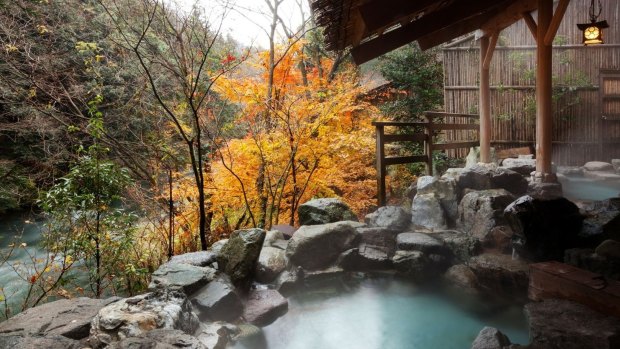This was published 2 years ago
Kaga Onsen, Japan: The most civilised place to get naked with strangers
By Keith Austin

There are thousands of onsens in Japan: indoor and outdoor, public and private.
I do love me an onsen, those bath houses built around geothermal springs in Japan. Ever since discovering the delights of Turkish baths in London in my 20s, I've always jumped at the chance to get hot and sweaty with a bunch of naked men – and onsens are among the most civilised places to do so.
I love the ritual and attention they apply to the pastime: the prescribed washing beforehand; the tiny hand towel which shouldn't ever go into the bath water; the polite injunctions to, essentially, shut up and relax. And in a country as volcanically active as Japan, there are thousands of onsens, indoor and outdoor, private and public. Bliss.
Kaga Onsen, a 30-minute train ride south along the coast from Kanazawa, in central Japan, is the collective name for a group of four hot spring towns, Yamashiro, Yamanaka, Awazu and Katayamazu. The springs are said to have been discovered by monks more than 1300 years ago and supposedly have healing properties, easing muscle and joint pain, improving recovery from disease, and making you look 20 years younger. (Though, looking in the mirror, I might be wrong about that last one.)
We are heading deep into the mountains, to Yamanaka Onsen, as part of a bespoke Inside Japan tour. We'll also be staying one night at a ryokan, one of the traditional inns with their tatami-matted rooms and communal baths that have been part of Japanese life for many hundreds of years.
A free shuttle bus meets us at the train station and takes us to our ryokan, the Kagari Kisshotei, which is distinguished by having a giant plastic crab attached to the entrance. You really can't miss it.
The ryokan is alongside Kakusenkei Gorge, which has the Daishoji River running through it. I end up in a room sporting both a Western-style bed and the means to make up a tatami mat one (the staff can also do it for you). The men's open-air onsen is at the bottom of the hotel and looks out across the gorge. It's an intimate space with natural hot water tumbling down through a series of small pools, which are shielded by the canopy of the trees growing on the riverbank below.
Tranquil and bosky, it positively encourages relaxation – and I am lucky enough to have it all to myself. If you use it between 4pm and 6pm you can partake of a free "happy hour". That night, we dine in the ryokan's Kagatobi restaurant. The food is excellent, though I have no idea what we had because the menu – rendered in Japanese script so beautiful it should be hung on a wall – doesn't come with English translations. There was fish, fish, fish, and some pickled stuff, all of which rivalled the aesthetics of the menu in both looks and taste.
Next day, in the very early morning, I head through the slumbering town to find a place to cross the river and check out the little pathway that runs along the other side. It's a beautifully clean and well-kept township with no high rises, just traditional Japanese architecture that melds modernity with elegance and simplicity without making a song and dance about it.
Specialities of the area include Kutani ceramic ware and Yamanaka lacquerware and the main street is awash with stores selling pieces. Indeed, the local Yamanaka-za Theatre's interior – pillars, ceilings and walls – is covered in the stuff. There's also a lacquerware museum in town.
To reach the riverside pathway from this part of town, you need to cross the Ayatori, or Cat's Cradle, bridge. This 94-metre-long span is conspicuous not just for its design, which incorporates a delightfully surreal S-shaped bend, but also because it's painted purple and provides a powerful counterpoint to the greenery of its rural setting.
There are excellent views up and down the gorge from the middle, and stairs on the other side leading down to a rough path that passes a small shrine and heads back past our ryokan. It's a tranquil walk with the purple bridge at one end and the Korogi-bashi (cricket) bridge at the other.And there's still enough time to get back to the ryokan for one more dip.
Keith Austin was a guest of Inside Japan Tours and Cathay Pacific.
Sign up for the Traveller Deals newsletter
Get exclusive travel deals delivered straight to your inbox. Sign up now.